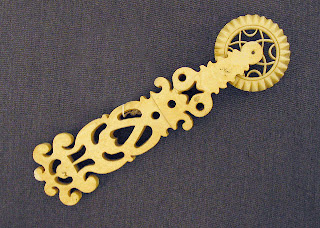 |
| sperm whale print, Sea Hag and Teratoma Press |
 |
| blubber to be boiled in the tryworks |
Captain William Davol of Westport, MA different grades of whale oil  whale bone or baleen was used in hoops, crinolines, and corsets  |
| most images from the New Bedford Whaling Museum |
I'm in the midst of a passing obsessional interest in whaling history. I do that periodically—reading multiple books at the same time on a subject while googling images compulsively (past episodes have tackled Academic art, apple names, and the trompe l'oeil craze of the late 19th century)— and this particular bout was triggered by an abortive visit to New Bedford, MA, while on my Victorian architecture program. We stopped in town to tour buildings but weren't given time to see the magnificent Whaling Museum. So I've been making a virtual visit by personal research.
I have to admit I was one of the legions of people who romanticize whaling. Fascinated by the paraphernalia, lingo and artifacts, and swayed by my soft spot for scrimshaw, I conjured up visions of whaling voyages that were damp, isolating and uncomfortable at worst. Mental reference images were part "Master and Commander", part "Narrative of Arthur Gordon Pym", mixed with a bit of Melvillean fervor and hoopla. Somehow I'd neglected to factor in the blood, blubber, guts, smoke, fires, filth, and stench. Even stories of shipwreck and cannibalism were mentally swabbed down.
were mentally swabbed down.
I have to admit I was one of the legions of people who romanticize whaling. Fascinated by the paraphernalia, lingo and artifacts, and swayed by my soft spot for scrimshaw, I conjured up visions of whaling voyages that were damp, isolating and uncomfortable at worst. Mental reference images were part "Master and Commander", part "Narrative of Arthur Gordon Pym", mixed with a bit of Melvillean fervor and hoopla. Somehow I'd neglected to factor in the blood, blubber, guts, smoke, fires, filth, and stench. Even stories of shipwreck and cannibalism
Whales were hunted for sperm oil for lighting and manufacturing lubricant, and bone or baleen for corsets,while occasionally they also provided ambergris, for perfumes. All this is vividly and comprehensively explained in Leviathan: The History of Whaling in America
"There is a murderous appearance about the blood-stained decks, and the huge masses of flesh and blubber lying here and there, and a ferocity in the looks of the men, heightened by the red, fierce glare of the fires..."— journalist J Ross Browne, 1846
“Everything,” a seaman wrote, “is drenched with oil. Shirts and trousers are dripping with the loathsome stuff. The pores of the skin seem to be filled with it. Feet, hands and hair, all are full. The biscuit you eat glistens with oil, and tastes as though just out of the blubber room. The knife with which you cut your meat leaves upon the morsel, which nearly chokes you as you reluctantly swallow it, plain traces of the abominable blubber. Every few minutes it becomes necessary to work at something on the lee side of the vessel, and while there you are compelled to breath in the fetid smoke of the scrap fires, until you feel as though filth had struck into your blood, and suffused every vein in your body. From this smell and taste of blubber, raw, boiling and burning, there is no relief or place of refuge.”
A general list of supplies for whalers ran to 48 pages with over 900 items and included 10 sizes of casks, 11 weights of sheathing copper, 27 forms of crockery, 58 varieties of food, 19 types of nails, 26 spare sails, 80 different types of whaling implements (harpoons, hooks, etc) ...
* " Rememb'ring all at Home... while we are Drinking Flip [beer, molasses, and rum] & Chasing Whales"—Peleg Folger, August 18, 1754.
* " Rememb'ring all at Home... while we are Drinking Flip [beer, molasses, and rum] & Chasing Whales"—Peleg Folger, August 18, 1754.















No comments:
Post a Comment